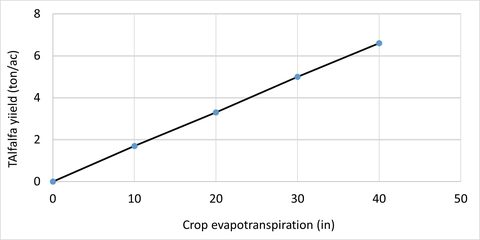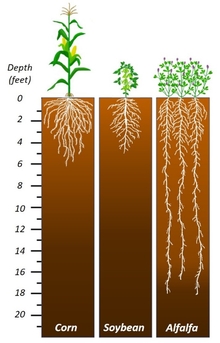Key points
- High temperatures combined with drought can severely affect establishment and growth of alfalfa.
- Alfalfa seed that has been planted and not yet germinated will survive in the soil during drought. It can germinate when rainfall occurs.
- Newly established seedlings are very susceptible to drought, because their root systems are inadequate.
- Drought and high temperatures will not kill established alfalfa, but will cause it to go dormant.
- Dormant alfalfa will recover following rainfall or irrigation.
- Alfalfa stands that are drought-stressed and ready for harvest should be cut. This is due to the potential for leaf loss.
Alfalfa uses a lot of water
Because of its high stem density and dense canopy, alfalfa has a high rate of water use. Alfalfa uses 0.1 to 0.3 inches of water per day (Table 1).
Daily water use is influenced by plant growth stage and environmental factors like air temperature and wind speed. For example, on a windy, 90° F day in Minnesota, alfalfa will likely use 0.30 inches of water.
Water use is greatest when alfalfa has a full vegetative canopy before harvest and is greater during summer months when solar energy and air temperatures are greatest.
Water use declines following harvests and is less in the spring and fall when the sun’s energy and air temperatures are lower.
Table 1. Alfalfa total water use for the first three weeds after the first and second cuttings
| Daily maximum temperature (°F) |
1 week after cutting |
2 weeks after cutting |
3 weeks after cutting |
|---|---|---|---|
| inches/day | inches/day | inches/dat | |
| 50 | 0.05 | 0.06 | 0.08 |
| 60 | 0.08 | 0.11 | 0.13 |
| 70 | 0.11 | 0.15 | 0.19 |
| 80 | 0.15 | 0.19 | 0.23 |
| 90 | 0.19 | 0.23 | 0.28 |
Scherer and Steele, Irrigation Scheduling by the Checkbook Method, 2019.
https://www.ag.ndsu.edu/publications/crops/irrigation-scheduling-by-the-checkbook-method-1
Crop water use and forage yield
Over the growing season alfalfa may use more total water than other crops because of its long growing season. There is generally a linear relationship between crop water use and forage yield, although aspects of this relationship vary somewhat based on other environmental factors. Water use ranges from 4 to 7 inches per ton of forage depending on the environment (Figure 1).
Alfalfa tolerates drought, but is not resistant
Alfalfa has an extensive root system that enables it to extract water from deep in the soil profile (Figure 2). Alfalfa roots are mostly concentrated in the top 4 feet of the soil, but it is not uncommon for roots to reach depths of 16 feet.
In response to soil moisture deficits, alfalfa increases its root mass and length. Alfalfa survives severe moisture deficits by going dormant. In the Midwest, alfalfa plants can survive several months in dormancy. In some climates dormant alfalfa can survive for years.
During the onset of drought, alfalfa plants increase carbohydrates stored in the crown to allow the plant to survive dormancy. When water becomes available alfalfa regrows rapidly from buds on the crown.
The physiological and morphological changes to moisture-stressed alfalfa ultimately reduces forage yield. Many changes are due to a dramatic reduction in photosynthesis. Morphological changes include a decrease in leaf size, stem number, stem diameter and stem length.
Initially alfalfa plants will cup or fold their leaves to decrease moisture loss. Under moisture stress, leaves are senesced beginning in the lower portions of the canopy. Soil moisture deficits also delay alfalfa maturity. The delay in maturity will reduce forage yields but can increase the forage quality of alfalfa (Table 2).
Table 2. Effect of moisture deficit stress level on alfalfa traits. Source: Halim et al., 1989. Agron. J.
| Alfalfa trait | High stress | Medium stress | Low stress |
|---|---|---|---|
| Maturity* | 2.5 | 3.4 | 4 |
| Leaf/stem | 0.8 | 0.63 | 0.6 |
| IVDDM | 65% | 64% | 63% |
| NDF | 40% | 41% | 43% |
*Maturity: 2=vegetative; 3=early bud; 4=late bud.
Moisture stress will also reduce biological nitrogen (N) fixation by alfalfa largely through its negative impacts on photosynthesis. Bacteria located in small nodules on alfalfa root hairs can normally fix 100-200 pounds of N per acre per year from the air and convert it to protein for plant growth. Moisture deficits reduce nodule mass, nodule number, and function of enzymes in the nodules. Therefore, the contribution of N to grasses grown in association with alfalfa, or to rotational crops will be reduced.
If drought occurs in the early stages of regrowth and less than a foot of regrowth has accumulated, avoid cutting the crop as the yield will be small. Alfalfa that is at or near harvest maturity and has accumulated appreciable yield should be harvested. If the drought continues, significant leaf loss will occur. As with all harvests, avoid excess wheel traffic in the field as stressed plants can be more susceptible to physical damage.
Drought affects alfalfa seeding by interfering with germination and stressing germinated seedlings that have small root systems. Seeds sown into dry ground will remain viable until adequate moisture is present; however, seeds that germinate and begin root emergence will die if insufficient moisture is present.
For successful establishment, alfalfa should be seeded at ¼- to ½- inch depth into firm seedbeds. These conditions provide good soil-seed contact which allows seeds to absorb water while minimizing exposure to extremes in temperature and moisture.
Within 24 to 48 hours after seeding, alfalfa will absorb water. Within 4-7 days, the root (called a radicle) emerges through the seed coat. Before radical emergence, the germination process can be stopped if moisture deficits occur. After radicle emergence, however, moisture deficits will kill the seedling. Even if the seedling emerges and reaches the first trifoliate leaf stage, it has little tolerance to drought because of its inadequate root system.
The growth stage at which alfalfa can tolerate extended soil moisture deficits has not been established, but by 8 weeks, the risk of drought damage is minimized as plants have a well-developed crown and multiple stems.
Irrigation
Determining how much irrigation water to apply is critical for water conservation and for profitable use of irrigation. Most irrigation scheduling focuses on prevention of yield-reducing stress while optimizing economic yields.
Water budgeting approaches or “checkbook scheduling” involves monitoring soil moisture in addition to determining daily crop water use through evapotranspiration (ET). Soil moisture can be monitored using moisture-sensing instrumentation. With alfalfa, irrigation typically begins with only about 50% depletion of available water in the root zone.
Other irrigation scheduling considerations unique to alfalfa include: 1) avoid scheduling during times of peak ET in the summer months, 2) avoid irrigation 1 week before harvest to facilitate harvest equipment and to avoid compaction, 3) irrigate immediately after a harvest, and 4) avoid irrigation when alfalfa is undergoing the dormancy reaction in the fall.
For more information, visit Extension's irrigation website.
Reviewed in 2023




